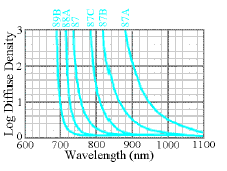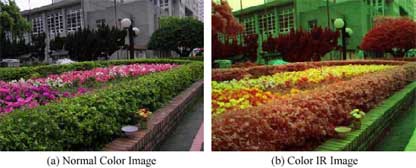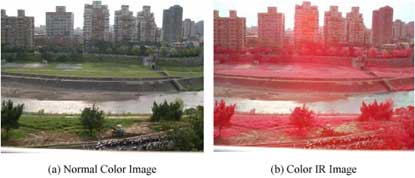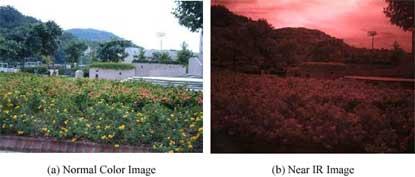| GISdevelopment.net ---> AARS ---> ACRS 2004 ---> New Generation Sensors and Applications: Digital Camera |
Acquisition of Multispectral
Images Using Digital Cameras
Hao-Hsiung
HUANG
Associate Professor, Department of Land Economics
National Chengchi University
Taiwan
Tel: 886229393091~50606 Fax: 886229379261
Email: hhh@nccu.edu.tw
Associate Professor, Department of Land Economics
National Chengchi University
Taiwan
Tel: 886229393091~50606 Fax: 886229379261
Email: hhh@nccu.edu.tw
ABSTRACT
Near infrared images are very useful for discriminating vegetation. Most of remote sensors can collect one or more than one band of near infrared image. A digital camera accompanied with IR filter can also provide near infrared image. An infrared image acquired in this way is much more mobile, convenient, and attractive.
Infrared sensitivity of various digital cameras has been tested in this research. Transmittance and adaptability of various filters have also been examined. Experimental results show that multispectral images collected by digital cameras are very similar to those images collected by space borne or airborne sensors. Approaches for acquiring and processing multispectral images by digital cameras are also described in the paper.
1. INTRODUCTION
Multispectral images are usually obtained using space borne or airborne platforms. Traditional film based cameras accompanied with filters can also take multispectral images. However, multispectral images using digital cameras are liked to have more mobility, convenience, and attraction.
The spectral sensitivities of digital cameras and the spectral transmittances of infrared filters are principal factors when acquiring multispectral images. This subject, procedures of acquiring multispectral images by digital cameras, and the statistics of multispectral images are described respectively in the following subsequent sections.
2. SPECTRAL SENSITIVITIES OF CAMERAS AND FILTERS
In general, digital cameras record image with CCD or CMOS sensors (Lillesand et al., 2004). If a silicon based CCD sensor is used, one may notice that this digital camera is an excellent sensor for the near infrared wavelength range of 750nm to 1000nm, as shown in Figure 1 (http://www.ph.tn.tudelft.nl/Courses/FIP/noframes/fip-Spectral.html).
However, digital cameras are generally not designed for taking near infrared images. Their sensors may not record infrared images without using IR filters. In other words, if an IR filter which can block wavelength below 700nm (visible portion), such as written 89B et al. shown in Figure 2, is used, one may examine whether the digital camera can record near infrared images or not.
A remote controller of television can be used to test the near IR sensitivity of a digital camera. One can take pictures of the IR beam of a remote controller with an IR filter placed in front of digital camera lenses. A light dot shown on digital image indicates that the digital camera can sense the near IR energy.

Figure 1. Spectral Characteristics of Silicon, The Sun, and The Human Visual System. (http://www.ph.tn.tudelft.nl/Courses/FIP/noframes/fi p-Spectral.html)

Figure 2. A Comparison of Infrared Filter Absorption Plots. (http://www.photo.net/photo/edscott /ir000020.htm)
3. MULTISPECTRAL IMAGES ACQUIRED BY DIGITAL CAMERAS
As stated before, accompanied with an IR filter, an IR sensitive digital camera can take near IR images. The IR filter also blocks some lightness. Therefore, exposure time should be long enough for showing the IR images somehow. According to various experiments, one to two seconds of shutter speed may be adapted. A tripod should also be used for stabilizing the camera.
In this study, the normal color images for three scenes were taken as shown in Figures 3(a), 4(a), and 5(a) respectively. For each scene, near IR images were also taken using the approach described above. The near IR image of scene 3 is shown in Figure 5(b). Both normal color image and near IR image can be split in three primary colors of blue, green, and red. As a matter of convenience, they are demoted as B, G, R, IR1, IR2, IR3 bands in sequence. Image data can also be presented in the intensity-hue-saturation (IHS) coordinate system. As explained below, the most useful band of near IR image is intensity one. Therefore, color IR images were generated as shown in Figure 3(b) and Figure 4(b) respectively. The results are “false color” images in which blue images result from green bands of normal color images, green images result from red bands of normal color images, and red images result from intensity bands of near IR images.
4. STATISTICS OF MULTISPECTRAL IMAGES
As described above, each scene has six bands of image, three bands are from normal color image, and the other three bands are from near IR image. In order to investigating if any redundant information existed in these six bands, the statistics of image data for scene 3 are, then computed as listed in Tables 1 and 2. Besides these, the optimum index factor (OIF, Chavez et al., 1984) can be used to evaluate the variety or similarity within any three of the six bands. The equation is shown in Eq. (1):
where Si is the standard deviation of band i, and |rij| is the absolute value of the correlation coefficient between any two of the three bands. The larger OIF, the three-band combination has, generally means the less amount of duplication or the more information, it has. Table 3 lists the OIF values for all of three-band combinations.
The statistics of Tables 1, 2, and 3 exhibit the information as follows:
- The IR1, IR2, and IR3 bands have the smaller range of brightness values than the B, G, and R bands have.
- The IR1, IR2, and IR3 bands also have the smaller standard deviations than the B, G, and R bands have. The IR3 band has the largest standard deviation among the three bands of the near IR image.
- Bands B, G, and R are all highly correlated with one another. Bands IR1, IR2, and IR3 are also all highly correlated with one another. But the lowest correlations exit while a visible band is compared with a near IR band.

Figure 3 Digital Camera Images of Scene 1

Figure 4 Digital Camera Images of Scene 2

Figure 5 Digital Camera Images of Scene 3



5. CONCLUSIONS
Multispectral images acquired using digital cameras have been proven to be feasible, reasonable, and efficient. The visual appearances of multispectral images collected by digital cameras are very similar to those of satellite images or aerial images.
Experimental results show that three bands of near IR images are highly correlated with one another. This indicates substantial redundancy in the information content among these bands. Experiments also appear that the IR3 band image has the richest information among three bands of near IR images. In actual operation, the intensity band image is sufficient to represent the three bands of near IR images. When generating the color IR image, radiometric corrections of either IR3 band image or intensity band image should be executed beforehand. Further research on application of the multispectral images acquired by digital cameras will be drawn.
REFERENCES
- Chavez, P.S., S. C. Guptill, and J. A. Bowell, 1984, “Image Processing Techniques for Thematic Mapper Data,” Proceedings, ASPRS-ACSM Technical Papers, 2:728-742.
- Eastman Kodak Company, 1992, Kodak Data for Aerial Photography, 6 th ed., Eastman Kodak Company, Rochester, NY.
- Debski, W., P. Walczykowski, A. Klewski, M. Zyznowski, 2004, Analysis of Usage of Multispectral Video Technique for Distinguishing Objects in Real Time, 20 th ISPRS Congress. http://digi.blueidea.com/dc/experience/2004/687.asp http://www.southcn.com/it/sheying/200209050246.htm http://www.photo.net/photo/edscott/ir000020.htm http://www.ph.tn.tudelft.nl/Courses/FIP/noframes/fip-Spectral.html
- Jensen, J. R., 2004, Introductory Digital Image Processing A Remote Sensing Perspective, 3 rd ed., Pearson Prentice Hall, Pearson Education, Inc., Upper Saddle River, NJ, p.163.
- Lillesand, T. M., R. W. Kiefer, J. W. Chipman, 2004, Remote Sensing and Image Interpretation, 5 th ed., John Wiley & Sons, Inc., pp.111-115.